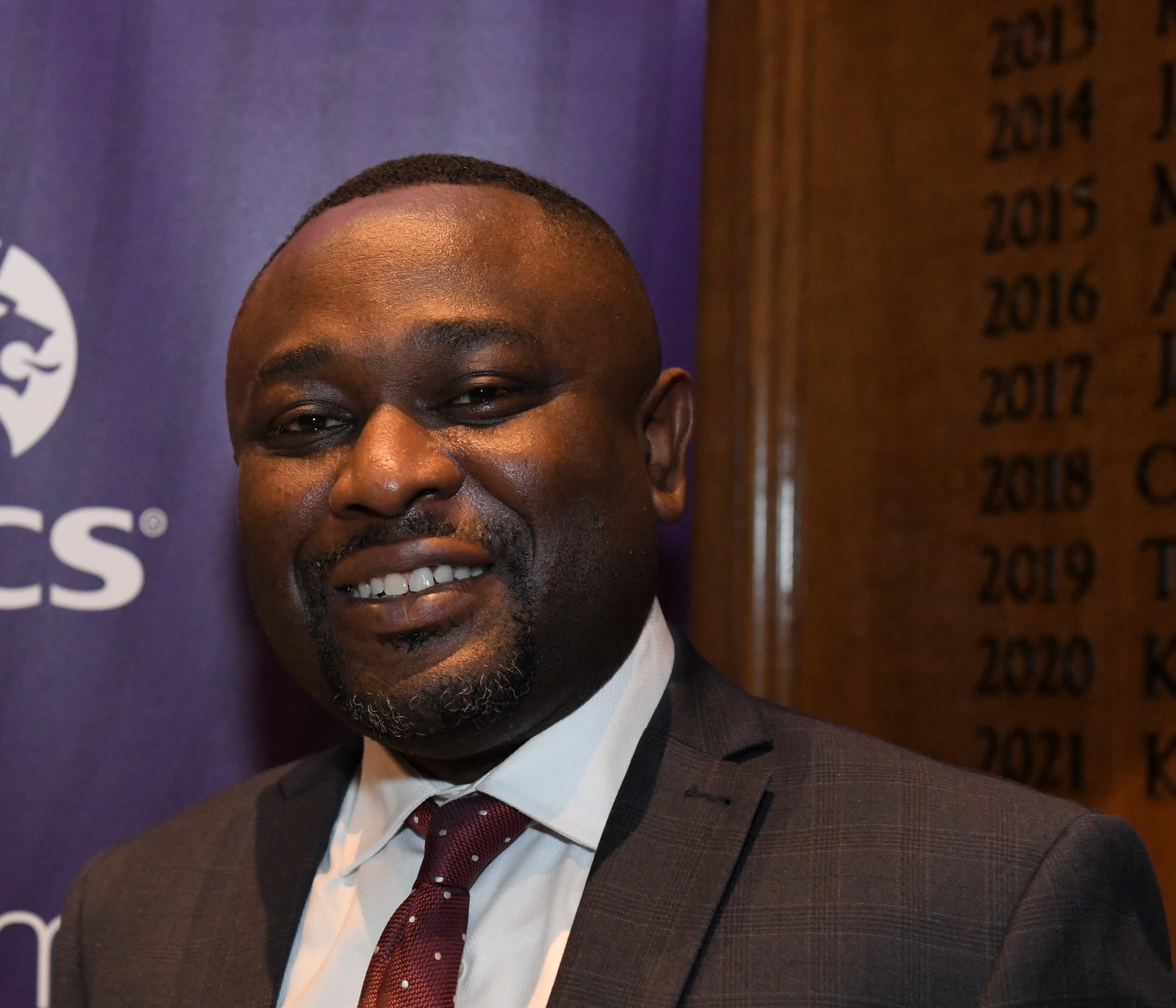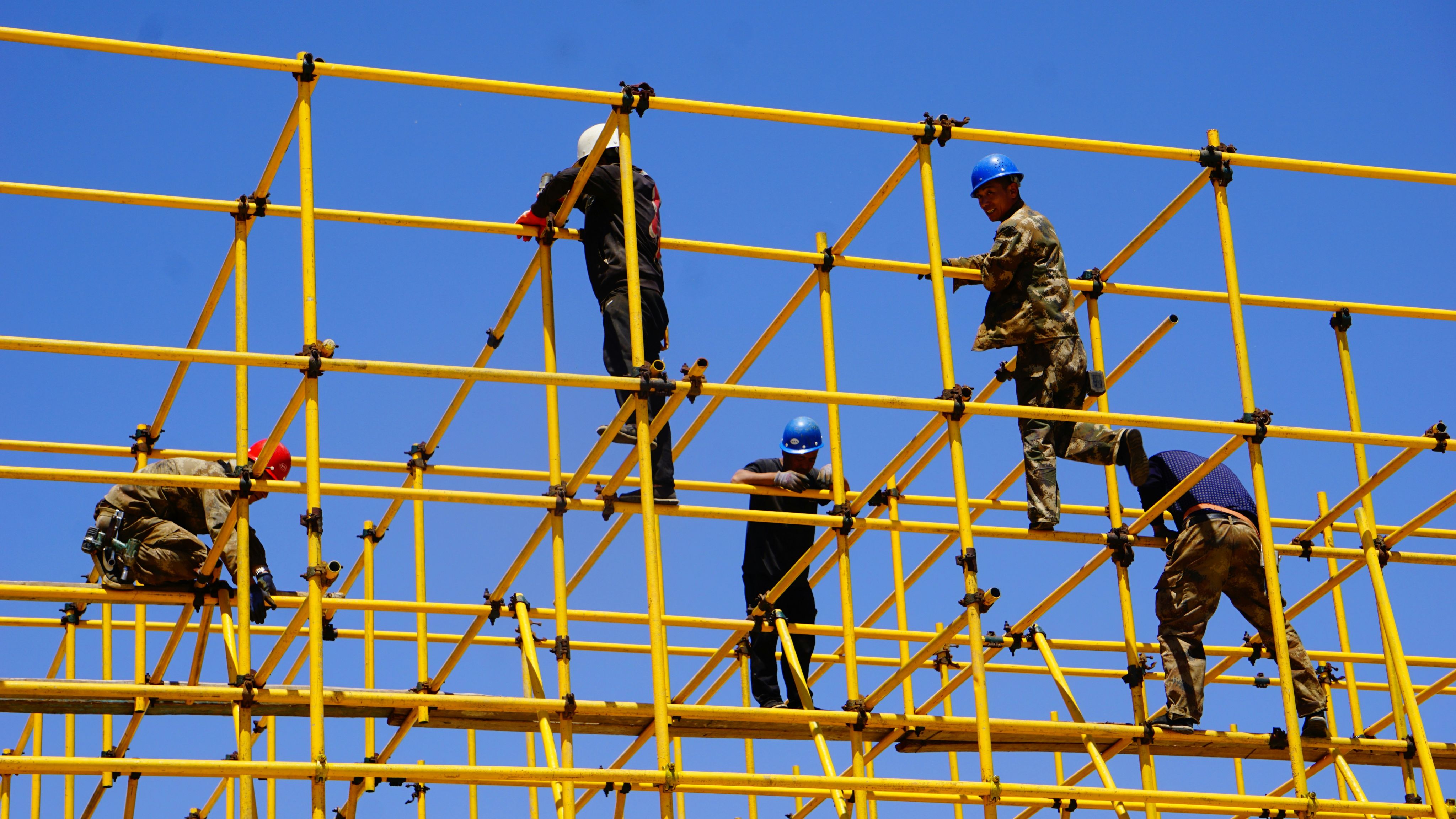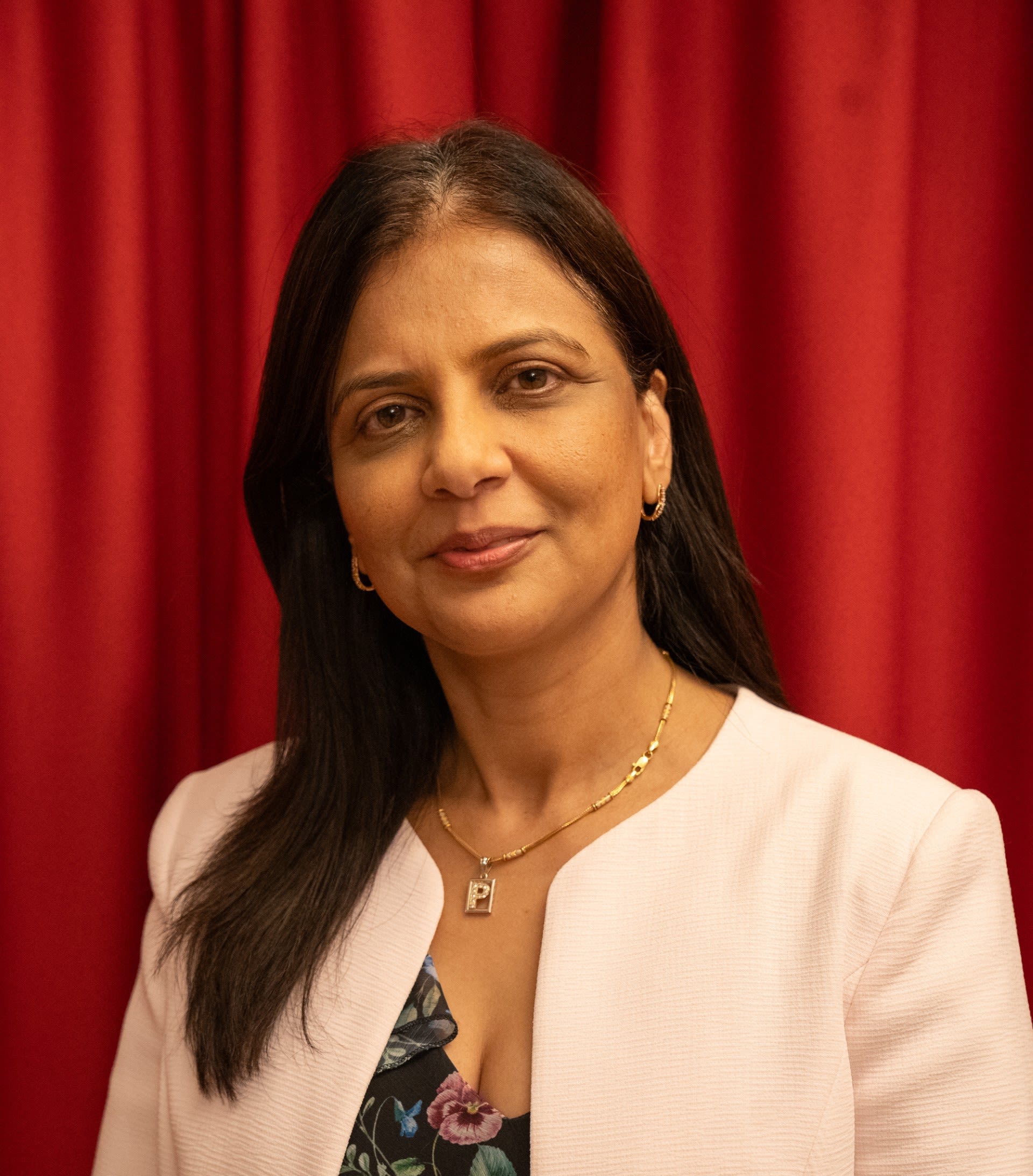Podcast: The AI Blueprint for the Construction Industry
Is the construction industry ready for the impact of artificial intelligence?

From smart buildings to robotics, and sustainability to skill shortages, can the construction industry effectively harness the power of AI?
Prof Priti Parikh is joined by Dr Abdul-Majeed Mahamadu, Dr Andrew Mitchell and Dr Vijay Pawar from UCL's Bartlett School of Sustainable Construction as they examine how the construction sector is adapting to the use of artificial intelligence, how quickly (or slowly) AI is being adopted, and the impact it will have now and in the future.
Listen to the podcast
Photo by Luke Jones on Unsplash
Photo by Luke Jones on Unsplash
Transcript
Voiceover:
This is a podcast from the Bartlett Review, sharing new ideas and disruptive thinking for the built environment, brought to you by the Bartlett Faculty of Built Environment at University College London.
Dr Vijay Pawar:
I had a conversation this morning from a company that wanted to deploy humanoid robots on a construction site so I think it might be happening sometime soon.
Dr Abdul-Majeed Mahamadu:
96% of all information that's generated within construction not being used. So something you can call dark data.
Dr Andrew Mitchell:
We need some work pushing forward to make tools specifically for the challenges that people on the ground in the construction industry are identifying that you know they could use help with.
Prof Priti Parikh:
Hello and welcome to this latest episode of the Bartlett Review podcast. I'm Professor Priti Parikh, Professor of Infrastructure Engineering and Director of the Bartlett School of Sustainable Construction. And today, we're going to talk about the impact that artificial intelligence, AI, is having, or perhaps should have in the future, on the construction industry.
Recently, Sir Keir Starmer visited UCL East, our campus at East London, and he highlighted the significance of AI in the future of built environment. And we know that the construction industry is one of the most environmentally damaging industries in the world but also an industry with significant growth potential in the future as we develop infrastructure and cities around the world.
Prof Priti Parikh:
With me today to talk about what AI can do to help us achieve this ambition are three of my brilliant colleagues here at the Bartlett School of Sustainable Construction. Dr. Abdul Majeed Mahmadu, who is an Associate Professor in Innovation and Industrialized Construction and Program Leader for the MSci in Construction Project Management. Welcome, Abdul.
Dr Abdul-Majeed Mahamadu:
Thank you very much, Priti.
Prof Priti Parikh:
Also with me is Dr. Andrew Mitchell, Lecturer in Artificial Intelligence and Machine Learning for Sustainable Construction. Good to see you, Andrew.
Dr Andrew Mitchell:
Yeah, thanks for having me.
Prof Priti Parikh:
And finally, Dr. Vijay Pawar, who is a lecturer in digital construction technology. Welcome to you too.
Dr Vijay Pawar:
Thank you very much. Pleasure to be here.
Prof Priti Parikh:
So AI is nowadays a buzzword that everyone seems to use, and it feels like AI, artificial intelligence is around us. It's really a part of our life. But let's get back to the basics. Andrew, tell me, what is AI?
Dr Andrew Mitchell:
So starting off with the easy question, AI is a big term, right? It covers a lot of things. It's a big umbrella. And I think a lot of people don't always realize that nowadays when people think of AI they would tend to think of something like Chat GPT these language models maybe the image generation models so those are a type of AI that we call generative AI but also under the umbrella of AI includes what people also may have heard of as machine learning which includes generative AI as well they fall under the umbrella of machine learning but ultimately the entire idea of AI is about making automated or computer systems that mimic things that humans do.
And it's actually quite an old field it comes out of the very beginnings of computing going back to the 1950s with Alan Turing and it's progressed through many different iterations over the last century. Ultimately what it's doing is different techniques to try and teach computer systems to do various things that we used to consider the purview of just humans.
Prof Priti Parikh:
And a phrase which gets thrown around a lot is smart, whether it's smart cities, smart technologies. I mean, are smart technologies and AI the same thing or are they different?
Dr Andrew Mitchell:
I'd say they're certainly not the same thing, but they're very closely related. So we've collected all this data from these sensors in say a smart building and we need some way to process that information and then make decisions based off of it and that's where the AI comes in. It might just be involved in the data processing so putting that raw data into a more understandable format or taking that and then actually making some sort of action in response to it.
Prof Priti Parikh:
And it's quite exciting for the construction sector as we could plant sensors, not just in buildings, but for kind of critical infrastructure in cities and really kind of monitor performance and trends over time. But there's also a lot of advances in work done around robotics and use of drones. And Vijay, I know you've been working quite extensively around this. So what do you think about that?
Dr Vijay Pawar:
I think it's a really interesting question and seeing how AI sort of expands its wings towards other disciplines like robotics is really interesting. So I guess where AI turns into sort of embodied AI or physical AI, this is kind of where that intersection is happening, where we're getting it transferred into real machines that can actually do things in the built environment. So imagine now sort of physical tasks, those dull, repetitive, dangerous, activities that otherwise, you know, that could be improved through the use of robots. So there are really exciting opportunities as AI kind of expands and, covers different types of applications. And you're right. So and it's enabling us to do things in different ways.
Prof Priti Parikh:
And I'm just reflecting on the potential applications further in the construction industry, both doing construction, but then post-construction. And Abdul, I know you've been doing a lot of work to this end.
Dr Abdul-Majeed Mahamadu:
Yes, Priti. So it's really exciting some of the things that AI can do, but I think first of all, we need to understand some of the challenges that we're actually hoping to alleviate using AI. You've mentioned already that the construction industry has a huge environmental impact. We've got a problem. Almost 40% of all global carbon emissions emanates from construction or the operation of buildings. And we also consume a high amount of non-renewable natural resources, which we use as construction materials for popular materials, such as timber, steel, as well as concrete. And so we've got an environmental sustainability problem. Second is skills shortages. In many developed economies, you've got an aging workforce. For example, in the UK, in the next sort of decade, we're likely to lose more than 10% of the workforce because the average age of a construction worker is between 50 and 56 years. The other side of the problem is that it's estimated that we need about a million extra workers in the next decade. However, we're not training nearly enough to fill those gaps. And so we do see a real opportunity for augmenting the workforce in terms of getting them to be more productive, or actually, if you look at robotics, actually replacing some tasks that previously we were doing, relying on humans.
Prof Priti Parikh:
So there are challenges with the construction sector one is around the skill shortage which I know that the UK government is really kind of focused on addressing but also inefficiencies both during the construction process post-construction during the operation of infrastructure and buildings. Challenges around managing emissions environmental impacts, do you think AI can help us solve some of those challenges?
Dr Abdul-Majeed Mahamadu:
Certainly, I think AI can help solve a number of these challenges. For example, intelligent design is coming up as a very valuable tool. This is the use of computational intelligence to generate a lot of design alternatives at the very early stage of design, where you can simulate and understand the impact of design, be it on energy, material selection, or material efficiency, or buildability. it's a well-known fact that up to 90% of construction projects with a run budget, anything between 30 and 70%, there are different schools of thought as to why we're always underestimating. Some think it's optimism bias. Others think it might be strategic misrepresentation. This is a very debatable topic, but at the heart of all of it is actually data and data that AI could help in relying on to provide better estimates, more accurate estimates, or some transparency in the estimates which we can use in benchmarking projects.
Dr Vijay Pawar:
And I would agree. I mean, the opportunity for innovation is huge. I think you're seeing lots of companies, start ups emerging, wanting to explore opportunities in this space, which is great. Equally, it's really hard to predict where the impact will be. everyone's trying to find that that killer app and trying to find where that return of an investment is that will you know change the industry going forward
Dr Andrew Mitchell:
I think an important thing to think about is like the different types of AI that we're talking about because you know as I mentioned at the start it's a broad umbrella so I tend to break it down into I guess like three sort of types of AI in use at the moment.
The first would be AI tools and that I think is what most people are thinking of at the moment they're thinking about okay how do I use something like Chat GPT in my daily work? Then I think there's some of the things that Vijay was talking about, which is automation. How do we use AI to make robotics or other automation systems more intelligent, more capable?
Then the middle one that is actually probably the biggest but gets overlooked the most in discussions about AI is predictive analytics. And so that can come down to things like schedule prediction and one of the big things for me is the best way that we can do this predictive analytics or make best use of AI tools particularly is to tailor them to the industry rather than trying to use these generalized ones and make them work for what we need. We need some work pushing forward to make tools specifically for the challenges that people on the ground in the construction industry are identifying that you know they could use help with.
Prof Priti Parikh:
So it's exciting that there's so much potential for the application of various types of AI in construction, but do you think the construction industry is ready for this or are we behind times?
Dr Andrew Mitchell:
I think there's some excitement around it people are interested in adopting AI or AI tools. Whether or not they're actually ready to start implementing them is a very different question. Particularly, as I said in my view, that we should be looking at specialized AI systems for this context. That takes some development and that takes cross-disciplinary knowledge between AI experts and industry practice experts. Like people who have been working in this field for a long time, who know what the challenges are, need to be talking with AI people and we need to have people who bridge in the middle.
Dr Vijay Pawar:
Yeah and like you're seeing huge progress in other sectors healthcare even manufacturing, they're starting to encourage the adoption of these technologies they're seeing good returns increasing productivity benefits from that and yeah you're right there's this curious case why construction is behind, there are unique aspects of the industry that you know that makes the adoption harder obviously you know that there are cultural aspects to it as well the industry is quite risk-averse so maybe there are opportunities here where we can sort of alleviate that through better partnerships, better collaborations that allow people to try things out but definitely I mean from a technology point of view we can solve a lot of problems and yeah we need the opportunity to try that out.
Prof Priti Parikh:
And the construction industry is a low margin industry so I assume that it's lagging behind in terms of investment in technologies as well
Dr Vijay Pawar:
Correct correct. So people will be very happy to try things out you know and explore the opportunity from a proof-of-concept point of view but ultimately the next step is does this make financial sense where often with the types of things that I do there's a high initial cost to trying these things out which puts people off.
Dr Abdul-Majeed Mahamadu:
Yeah, I agree with all of the points. Another issue that kind of makes this problem worse is the fact that the industry is project-oriented. And so from project to project, we do lose a lot of innovation. There are clients who would pay for investments in specific types of technology and their application. However, beyond their projects, it’s normally difficult for us to move all of the learning onto other projects.
Prof Priti Parikh:
And I guess with projects, if they have a duration of three to five years, it's difficult to make the business case to invest in kind of longer-term technologies to set that foundation. And we're working with the assumption here that AI has wide-ranging benefits, but are there risks associated with AI or the use of AI in construction?
Dr Vijay Pawar:
I mean, definitely with the codes that I create. So, no, I do a lot of work sort of onsite, the application of practical systems, working at height or working with heavy payloads. Naturally, there's a strong health and safety aspect to that. If I’m trying to deploy a swarm of drones to do construction on site, if something goes wrong there's a problem you know and so thinking about ways of how these systems can fail gracefully is really important and that's kind of areas of new research that sort of needs to happen. Second to that is then probably then linking that back to regulation So assuming we can encourage hearts and minds around this, good thinking around good practices, then we can get the opportunity to then do more on site. And then people will think these new approaches are less risky to then try out.
Prof Priti Parikh:
And I like the phrase you use, failing gracefully, because there's the notion that AI can never go wrong. But we know that with automation, there are those risks and challenges. And that perhaps also poses an ethical dilemma as well.
Dr Andrew Mitchell:
One of the primary differences with machine learning and AI compared to you know being on this spectrum compared to statistical analysis is that the way these things are trained is the focus is entirely on prediction. Right so we don't care, we often tend to treat them as a black box we don't know what's going on inside of it but we trust it if we have robustly tested that it gives us good predictions consistently and so that can be a challenge I think for a lot of engineers to accept because they're used to understanding what's going on under the hood so that's one actual risk of these AI systems is are we confident about their predictions, are we confident about the decisions that they're making and the way to mitigate that is to make sure that we have very robust testing strategies around them.
But there are other risks as well you know there's the two big ones that people have discussed are sustainability and environmental impacts of the AI models themselves. The carbon emission outputs of generating the energy to train this model this large language model was equivalent to about 30 flights between New York and London which is a significant output. That said the nice thing is you train the model once and then everybody is benefiting from that energy outlay. On the other hand when you run a model, each time you run a model you're also generating these new carbon emissions to generate the energy for it it's a very significant thing, But whether it's enough to say we shouldn't be doing it is kind of an up-in-the-air question.
Prof Priti Parikh:
But, I mean, the statute provided on emissions is quite startling, though, because we assume that when we run models, it does not consume energy, but it does. And that possibly Abdul kind of poses present-day risks around life cycle and efficiencies and...
Dr Abdul-Majeed Mahamadu:
Yeah, so there are other risks. For example, one of the topical issues spot accountability and responsibility. So most construction professionals or firms owe their clients a duty of care to deliver services at the right level of competence or expertise. And so when you rely on AI there could be a dilemma of when things go wrong who's actually responsible and as these systems become more complex determining responsibility of actions or incidents becomes even more challenging and so there are issues around human oversights of things that are produced out of AI which we should really be engaging with in the industry especially given our industry is one that's quite known for litigation and people having issues with each other amidst all of the low margins.
Prof Priti Parikh:
And I want to come back to the point of skills and workforce because in the construction industry we are already facing a shortage of skilled workforce. Now with the adoption of AI technologies models in the future would that impact the future needs in terms of skills, would that impact human safety?
Dr Vijay Pawar:
I mean definitely because I mean you're now shifting a requirement towards having sort of IT savvy trained people to come towards construction as a viable career. Now yeah at the moment you know even my PhDs they are getting six-figure offers on sort of generic applications of AI. Now can construction even afford that level to begin with? Don't know. So I think there's a there's definitely a training element around where we can possibly help where we can encourage new skills or training up the next generation to be really interested in construction problems and then apply these types of technologies to them to sort of create that workforce.
Dr Andrew Mitchell:
Yeah, I think, as was mentioned, there's definitely a skills gap of the real technical skill to work with and train these models, even speaking for us universities need to do better about not just talking with students about you know what are the some of the problems with these models but how to use them more effectively.
And so if we then think about okay what if we now have an AI that can handle the junior level structural engineers work now you just need the mid-level person who can instruct it to do some calculations or something in 10 years how are you going to have the mid-level engineer and so it may end up exacerbating our skills gaps and our skills problems, because we're not letting people get that lower level training.
Prof Priti Parikh:
So at Bartlett School of Sustainable Construction, we are already looking into how we better embed AI in our curriculum, especially for our undergraduate programs to develop that pipeline of future leaders who are AI aware, who understand the risks and opportunities and can pave the way for construction industry.
Dr Abdul-Majeed Mahamadu:
Yes, and Priti, I think that's a very timely introduction of these pathways in training of future graduates, because there will be a lot of new roles that emerge within construction related to data. Currently, reading some research from Autodesk, KPMG, and other consultancy firms, they kind of quote some statistics, which points to about 96% of all information that's generated within construction not being used. So something you can call dark data. We will need an army of people to actually start deriving some value out of that data, because compared to other industries, they're using probably up to 50% of the data that they generate for some value, either through insights or commercialization of the data. In construction, we don't do as much. And so I do see quite a gap in terms of requiring people with AI skills that can actually start deriving some value out of all of the data we collect in construction processes.
Dr Andrew Mitchell:
I think this points to me to one of the biggest sort of knowledge gaps in the industry, your you know 30, 40 years’ worth of project reports that your company has is exploitable data particularly now with these language models they are now very good at taking what's called unstructured data things like pdfs, project schedules that we wouldn't normally think about but they're very good at parsing those and turning them into usable information and I think that's one of the big things that we need to start educating and teaching people is how do you think about this data what can you actually do with it and which data is valuable.
Dr Vijay Pawar:
Yes I think you know training people to learn how to use the tool to investigate, to research, to actively exploit the information that you have is really important because that's very different to just replacing a calculation. And so if we can embed that practice into how we use these tools, that's hugely valuable.
Dr Andrew Mitchell:
It leads to actual advancement rather than just maybe more efficient, more productivity. It's how can we actually advance it.
Prof Priti Parikh:
And thinking about advancement, Sir Keir Stammer recently was at UCL, and he really showed firm government commitment towards advancements in AI. But if you think about the role of government in construction, how can governments help us in managing risk? And Vijay, you alluded earlier to health and safety as a risk, but equally, how can governments help us to shape an enabling environment to further bring in some of the AI technologies into construction?
Dr Vijay Pawar:
Yeah so I think given the types of tools and sort of robots that we are naturally developing it is encouraging a very different way of working. It's a bit like kind of the journey that self-driving cars has gone through. They created the different levels of automation, created standards thresholds for technology to meet before we can then get things deployed and it's those sort of activities, initiatives where I think community government-led effort can really help.
Dr Abdul-Majeed Mahamadu:
Yeah, I think government can play a very important role. So I'm particularly excited about the UK's AI Opportunities Action Plan, which the Prime Minister recently launched. In that document, they've mentioned the vision of investing in the foundations of AI, including infrastructure that will support AI. I see some opportunities there for our industry in terms of providing that infrastructure itself. So there's going to be construction of data centres if the UK wants to be a global leader. And that's something we can participate in. They've also mentioned AI growth zones, including establishment of a national data library. So this is where there's going to be a lot of democratized data that everybody can have access to, that they can use for their own AI developments. Most of the use cases being mentioned are in healthcare and other industries. So I think construction industry really needs to get our foot in there in terms of contributing data so that eventually there will be use cases that would be useful to us. Because if government is providing this sort of enabling environment, we really should be taking advantage of it as well.
Dr Andrew Mitchell:
I think that really brings back to one of the earlier questions of is the industry ready for it. You mentioned self-driving cars before or we look at the other big advancements. Every time that there's been a big advancement in AI it's been off the back of new, big, open data. So the main thing that drives the development of not just new applications or anything like that, but new models, new model architectures and new applications is when we get new data that can actually contribute to this. And so one of the biggest things that the construction industry, I think, needs to realize is if they want advancement and innovation in AI for their industry, they need to be willing to share that data, not just with, oh, yeah, we're going to make our model. You know, we're a construction company. We're going to make our model. So we're going to hire an AI company to use our data. I don't think that's good enough. They need to be willing and find ways to share that and pool that data across the entire industry to make a benchmark data set.
Dr Vijay Pawar:
And that probably requires a bit of a cultural shift yeah you know to sort of open data sets, open standards, open code. I think that's kind of where government can really help to provide incentives to sort of create that environment so then we can then, because I think I guess AI is at the moment you're creating platform technologies right you know things that eventually will get big enough and sophisticated enough to then be more specific to sort of go forward and so it really needs these open access models source code data so that we can all work together.
Dr Andrew Mitchell:
One of the big challenges that is very legitimate for these companies about sharing the data is their confidentiality right particularly if we're talking about okay we want to you know innovate in AI for project management the data we need from them are their project documents, they're not going to share that and that's fair right. So the industry needs to do the work to figure out how can we enable them to share the information that we need without running the risk of confidentiality so that might be things like synthetic data or data anonymization and I think that there are going to be specific methods and tools that will be necessary to deal with the challenges of this industry specific data. And so I think that will come from within the industry to figure out the definitions of what their concerns are and how to address it to then feed into the government-enabled things like this data library.
Prof Priti Parikh:
Are there best practice examples internationally where we can learn from and exchange knowledge?
Dr Vijay Pawar:
I mean I think it's a hugely changing landscape I mean, obviously, you know, there's excellent work coming out of China. And, you know, naturally, there's good innovations happening in the US. Even in Europe, they're developing Horizon calls around construction, around the use of AI and collective robotics to see how that can increase innovation and productivity. The UK needs to participate in otherwise you know it could be locked out or…….
Prof Priti Parikh:
Left behind really.
Dr Andrew Mitchell:
I actually would bring up some concerns over actions that governments have taken on this so one of the concerns underlying these large language models is the AI companies right to the data that they trained on right so models like GPT were trained on a data set that was scraped from the entire internet and in many cases disregarded any copyright claims that the content owners had and they make arguments that we're training it's learning from that so it's not it's not a copyright issue. I would disagree with that even on technical reasons but that's been a generalized concern that people particularly artists have brought up is you don't have the right to train on my content unless you pay me for that right, you license it or unless I've given you that right and that has not been litigated has been sort of swept aside but it's a very legitimate concern
Prof Priti Parikh:
And for large construction firms it means that they have to reset or rethink how they manage curated data.
Dr Abdul-Majeed Mahamadu:
Yes absolutely and so AI depends a lot on data and for you to train these models a lot of the time you need data in consistent formats and structures and so there needs to be some effort on global standardization of data for various aspects of construction. There's been those efforts for many years, but I think now we can really have a goal towards standardizing it for data analytics and for the exploitation of AI. In terms of costs data presentation, at least there's one example that I can cite. The international costs management standards is a global standard that's emerging for sort of guiding the presentation of cost data across the world. And that level of consistency would ultimately lead to having data in very similar formats across the world that can be leveraged for AI.
Prof Priti Parikh:
We've just had a brilliant conversation about the opportunities and risks of AI in construction. I wanted to take you into the future. Imagine we were to travel in time. And I only say that because we seem to be recording this in the studio, which does look like the TARDIS. And if we were to travel in time to a construction site in the future, will there be human beings on the site or will we be fully reliant on drones and robots? Vijay?
Dr Vijay Pawar:
Funny enough I had a conversation this morning from a company that wanted to deploy humanoid robots on a construction site so I think it might be happening sometime soon. I guess yeah I mean I think I'd obviously advocate the use of more robots I think that's my area of expertise keeps me in the job at least anyway and I think there's obviously a moral case around if it's helping to complement human working especially for very risky dangerous jobs that it can be better more reasonably done with a robot I think you know there's a moral case for that and that's kind of I'd like to see the innovation to occur.
Prof Priti Parikh:
What about you Abdul?
Dr Abdul-Majeed Mahamadu:
Yeah certainly I can see a future where we're using more of these autonomous agents and systems, including robots. However, in the medium term, I don't see us completely eliminating humans on construction sites. So what's going to happen is we're probably going to have both humans and robots working in the same spaces. So that also raises other safety risk issues around human machine interaction. And so that's my prediction of what's going to happen in the medium term.
Prof Priti Parikh:
So Andrew, in 20 years time, where do you see AI in construction?
Dr Andrew Mitchell:
I think I'll say what I hope to see. So what I’d like to see over the next five or ten years is the professional societies within the industry getting to grips with what they need to regulate within their industry because that's where I think that that sort of regulation should come from and getting to grips with how they can really lay the groundwork.
So as we've mentioned how do we make these open data sets that are relevant to our industry, how do we provide the tools and the baselines for that? And then once that is laid hopefully in the next 10 years or so I would then love to see experimentation, people working with those data sets and identifying the places that AI can really have an impact so I think once we have that baseline we will see things that we haven't even considered right now applications that we haven't even thought of at the moment because we can't see them until we can start experimenting and trying out with it.
So I don't necessarily know what it'll look like in 10 or 20 years because I don't think we really can until we have that baseline to start experimenting with.
Prof Priti Parikh:
And that's what makes AI exciting, that we are planning for an uncertain future and thank you for a brilliant conversation today.
Prof Priti Parikh:
My thanks to Vijay Pawar, Andrew Mitchell and Abdul Majeed Mahmadu and for more information about the Bartlett you can visit our website ucl.ac.uk forward slash Bartlett and follow us on LinkedIn at the Bartlett UCL's Faculty of Built Environment.
About the speakers

Dr Abdul-Majeed Mahamadu
Associate Professor in Innovative and Industrialised Construction

Dr Vijay Pawar
Photo by Conny Schneider on Unsplash
Photo by Conny Schneider on Unsplash
Learn more about construction and digital technology
At the Bartlett School of Sustainable Construction we offer a range of leading undergraduate, master's, MBA and research programmes, equipping students with future skills in AI and digital technology.
Podcast produced by Adam Batstone
© UCL The Bartlett 2025





